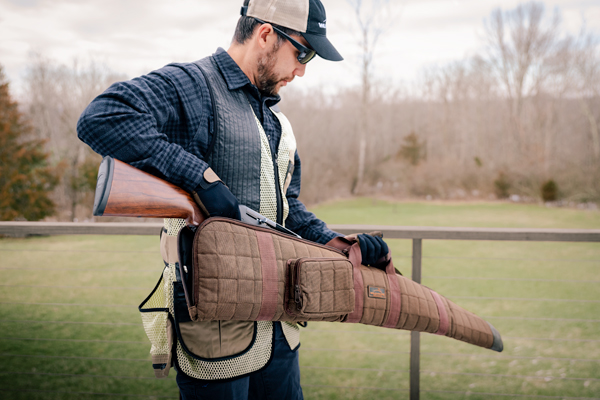PRODUCT CARE GUIDE
Storage
Store jacket and coat in a well ventilated, climate controlled area out of direct sunlight. If your gear becomes wet, allow it to air dry completely before storing.
The leather shooting pads and trim are natural animal hide and can form mildew or even deteriorate if moisture is not allowed to evaporate. If the leather becomes wet, allow it to completely air dry and follow with an application of Leather Salve before storing.
Maintenance
At least twice a year, or when the leather trim and shooting pads appear to be drying out or after washing and allowing to dry, apply Leather Salve with a dry rag and rub into the leather.
The durable water repellent (DWR) finish will degrade over time and will occasionally need to be replenished. The garment will perform at its best if you maintain the DWR finish. A simple way to test your garment’s DWR finish is to lightly spray or splash it with water and see if the water is beading up or being absorbed by the fabric. If the fabric ‘wets out,’ it’s time to revive the DWR finish. When it’s time to re-treat the DWR finish, we recommend a DWR replenishing product like Nikwax® TX.Direct Wash-In or TX.Direct Spray-On. Apply Leather Salve before spray. Overspray of DWR on the leather may prevent the leather from absorbing the salve. Try to prevent overspray by covering the leather during application.
Cleaning
Machine Washing:
Machine wash cold with a high performance cleaner like Nikwax® Tech Wash, or if you elect to use a conventional liquid laundry detergent (non-chlorine only), we recommend a second rinse to remove all traces of detergent from the fabric. Do not use fabric softeners, bleach or stain removal products and never dry-clean your garment. Do not iron. Air dry completely before storing. We like to hang-dry our gear above a supply vent to speed up the drying process. Once dry, apply Leather Salve with a dry rag and rub into the leather shooting pad and trim.
Storage
Store your coat in a well ventilated, cool climate controlled area out of direct sunlight. Waxed garments should always be hung and never folded. Folding can cause heavy creasing and mildew or mold growth on interior areas.
If your gear becomes wet, allow it to air dry completely before storing. The leather shooting pads and trim are natural animal hide and can form mildew or even deteriorate if moisture is not allowed to evaporate. If the leather becomes wet, allow it to completely air dry and follow with an application of Leather Salve before storing.
Maintenance
Apply a fresh coat of Heavy Duty Wax to the fully dried fabric every year or whenever water seems to penetrate the fabric. To reduce tack, allow the wax to fully cure for at least 48 hours in a warm, dry place.
To freshen your coat, spray the unwaxed side (the interior) with Odor Eliminator.
At least twice a year, or when the leather trim and shooting pads appear to be drying out, apply Leather Salve with a dry rag and rub into the leather.
Cleaning
Never wash, soak, submerge, or dry-clean waxed/oiled fabrics. Spot-clean only using Waxed Canvas Spot Cleaner.
Spot Cleaning Oil Tin Fabric:
1. Apply a pea-sized amount of the Waxed Canvas Spot Cleaner to the area to be cleaned
2. Dip cloth or brush into a bowl of warm water and scrub to loosen dirt, stain, etc.
3. Rinse cloth or brush and repeat until stain is removed
4. Allow area to dry completely before reapplying waxes or oils
To simplify your oil tin fabric upkeep and cleaning, we offer the Waxed Canvas Care Kit. This kit contains everything you need to help your gear last a lifetime:
Spot Cleaning the Leather Trim & Shooting Pads:
In most situations, you can simply wipe the leather with a damp rag, let the leather dry and apply Leather Salve.
In cases of severe staining or dirt on the leather, complete the following instructions while taking care to not get the leather care products on the oil tin fabric:
1. Apply Saddle Soap to leather using a damp cloth
2. Use soft-bristle brush to create foam
3. Scrub away dirt and stains
4. Wipe leather clean with a dry cloth
5. Reapply as often as necessary
6. Follow up with Leather Salve to condition
To simplify your leather upkeep and cover all your leather needs, we offer the Otter Wax Leather Care Kit. This kit contains everything you need to help your gear last a lifetime:
1. Saddle Soap to gently clean your leather and remove stains
2. Leather Salve to restore softness and repair cracking
3. Leather Oil to polish and revive the natural shine
4. Boot Wax to protect and create a waterproof seal
5. Flannel buffing cloth for application
6. Instructional Card
Storage
Store vests clean in a well ventilated, climate controlled area out of direct sunlight. If your gear becomes wet, allow it to air dry completely before storing.
If your vest has leather shooting pads and trim keep in mind this leather is a natural animal hide and can form mildew or even deteriorate if moisture is not allowed to evaporate. If the leather becomes wet, allow it to completely air dry and follow with an application of Leather Salve before storing.
Maintenance
Shooting Vests:
Check seams and zippers periodically to make sure they have not been compromised. If vests start to build up sweat, dirt or grime, follow cleaning instructions. If your veest has leather trim and shooting pads, at least twice a year, or when the appear to be drying out or after washing and allowing to dry, apply Leather Salve with a dry rag and rub into the leather.
Upland Vests:
Check seams and zippers periodically to make sure they have not been compromised. We recommend you hose or rinse out the game pouch after each successful hunt. You can use a mild detergent (non-chlorine) for stubborn debri.
Cleaning
Machine Washing:
Machine wash cold with a mild laundry detergent (non-chlorine only). Do not use fabric softeners, bleach or stain removal products.
For vests with leather accents, air dry completely before storing. We like to hang-dry our gear above a supply vent to speed up the drying process. Once dry, apply Leather Salve with a dry rag and rub into the leather shooting pad and trim.
If your vest does not have leather, you can tumble-dry low (coolest setting) for the shortest amount of time necessary.
Storage
Store leather gear in a well-ventilated, climate controlled area out of direct sunlight. Do not store leather in plastic bags or bins. Leather is a natural animal hide and can form mildew or even deteriorate if moisture is not allowed to evaporate.
To keep your leather gear from fading and becoming dry DO NOT store in direct sunlight. Doing so can cause colors to fade in exposed areas and possibly weaken the leather.
If your leather gear becomes wet, allow it to completely air dry and follow with an application of leather maintenance/protectant oil before storing. We recommend using this oil for basic upkeep: Leather Salve.
Maintenance
For continued durability and performance of all your leather gear, we strongly recommend using leather protectants, oils and cleaners as needed. At least twice a year, clean off any dirt and apply Leather Salve with a dry rag and rub into the leather.
Cleaning
For non-staining debri, allow debri to dry first and gently brush off as much debri as possible before beginning the cleaning process.
1. Apply Saddle Soap to leather using a damp cloth
2. Use soft-bristle brush to create foam
3. Scrub away dirt and stains
4. Wipe leather clean with a dry cloth
5. Reapply as often as necessary
6. Follow up with Leather Salve to condition
7. Follow up with Leather Oil to shine
8. Follow up with Boot Wax to protect
To simplify your leather upkeep and cover all your leather needs, we offer the Otter Wax Leather Care Kit. This kit contains everything you need to help your gear last a lifetime:
1. Saddle Soap to gently clean your leather and remove stains
2. Leather Salve to restore softness and repair cracking
3. Leather Oil to polish and revive the natural shine
4. Boot Wax to protect and create a waterproof seal
5. Flannel buffing cloth for application
6. Instructional Card
Storage
Store fabric gear in a well ventilated, climate controlled area out of direct sunlight. If your gear becomes wet, allow it to air dry completely before storing.
Maintenance
Check seams and zippers periodically to make sure they have not been compromised. If straps or fabric, begin to build up grime or dirt, follow cleaning instructions.
Cleaning
For non-staining debri, allow debri to dry first and gently brush off or vacuum as much debri as possible before wetting the bag.
Spot Cleaning:
Wet a rag and blot the soiled areas, always using a clean part of the rag, until the soiled area is clean. For non-water soluble debri, use non-chlorine detergent diluted in water and repeat the blotting process, followed by blotting with a clean wet rag. Air dry completely before storing.
Hand Washing:
If the entire bag requires cleaning, fill a sink, tub or basin with cool to warm water (around 90°F) and a dose of non-chlorine detergent. You can use a soft scrub brush on the exterior of the bag. Rinse well. Reform your gear. Air dry completely before storing. We like to hang dry our gear above a supply vent to speed up the drying process.
Machine Washing:
Machine washing is not recommended for larger gear as the washing machine usually becomes unbalanced. For smaller gear, machine wash gentle or casual cycle with a cool to warm water setting (around 90°F). Only use non-chlorine bleach. Reform your gear. Air dry completely before storing. We like to hang dry our gear above a supply vent to speed up the drying process.





